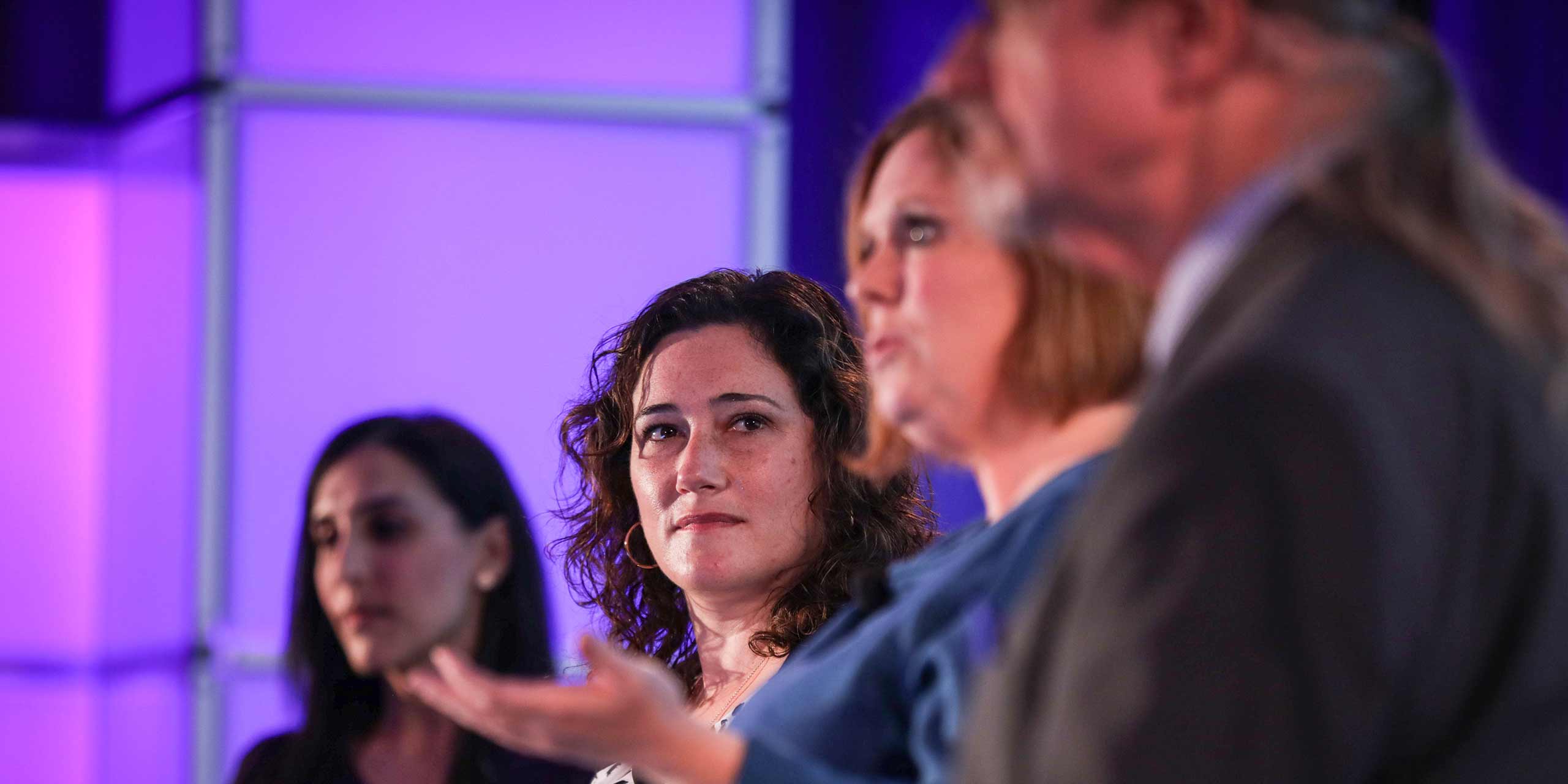Jenel Cavazos and Greg Kitzmiller agree: if there’s one classroom tactic that’s effective at personalizing the student experience in their classrooms, it’s the word cloud. Often found on websites and in presentations, word clouds are clever graphic depictions of search terms and answers to open questions, with the most common words appearing in large print. And the immediate impact of the word cloud, according to these two faculty members, is for students to be able to see their own individual position within a group.
“It’s great because you can ask students something as simple as a personality trait that best defines them,” explains Cavazos. “When you display the results, they can see how popular their own answer was, as well as all the different answers offered by their peers, and they immediately connect with that. Displaying student-generated data has a tremendous impact.”
It’s a simple but effective personalized learning tactic that, by keeping students engaged and making the class meaningful to them individually, has the potential to improve student outcomes.
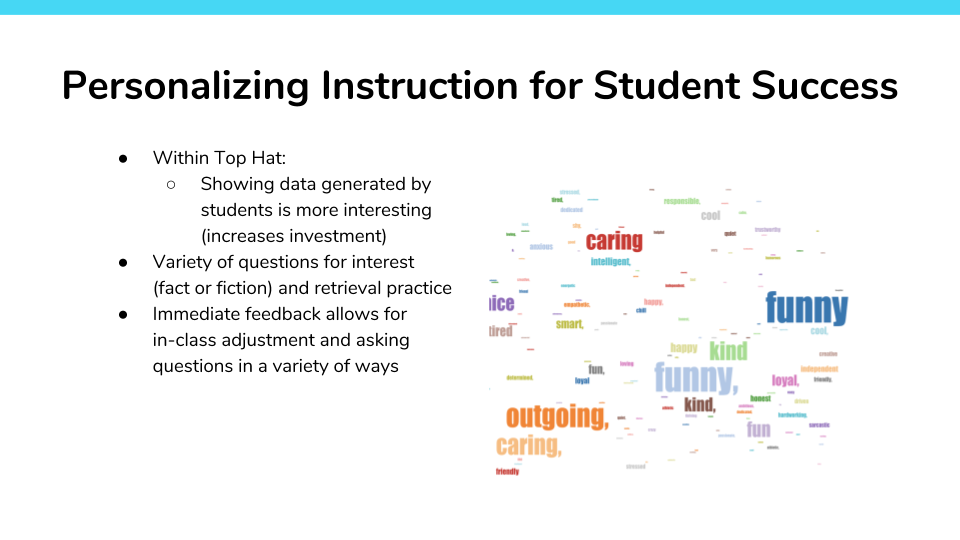
Kitzmiller’s experience has been similar. “I want my students to all have a personal stake in their learning so I’ve got to find a way to keep them involved” he says. While classroom response systems have long provided real-time student results to multiple choice or true-false questions, the word cloud—a feature of some classroom engagement platforms including Top Hat’s—allows for more unique answers. “Word clouds look and feel like a group personality. Students love them.”
Cavazos, a professor of psychology at the University of Oklahoma, and Kitzmiller, a professor of marketing at Indiana University, both presented in a panel discussion entitled “Connections in the Classroom—Personalizing Instruction for Student Success” at the Engage 2018 conference hosted by Top Hat in Chicago last October.
Personalization is a relatively new but rapidly trending topic in higher education. As the Millennial generation has mostly graduated from college, Generation Z is now following in its wake. This cohort, born between the years 1995 and 2010 according to Forbes (although there remains some debate about where Gen Z starts and ends), is the first to have been born in the fully digital era of internet connectivity—and they are accustomed to the personalized advertising and social media streams algorithmically curated for their values, attitudes and tastes.
But personalization is more than just a generational expectation; it holds the potential to help students succeed. Advances in educational technology, as with personal devices, make it possible to assess individual performance, identify gaps in individual learning, and help faculty address and bridge those gaps.
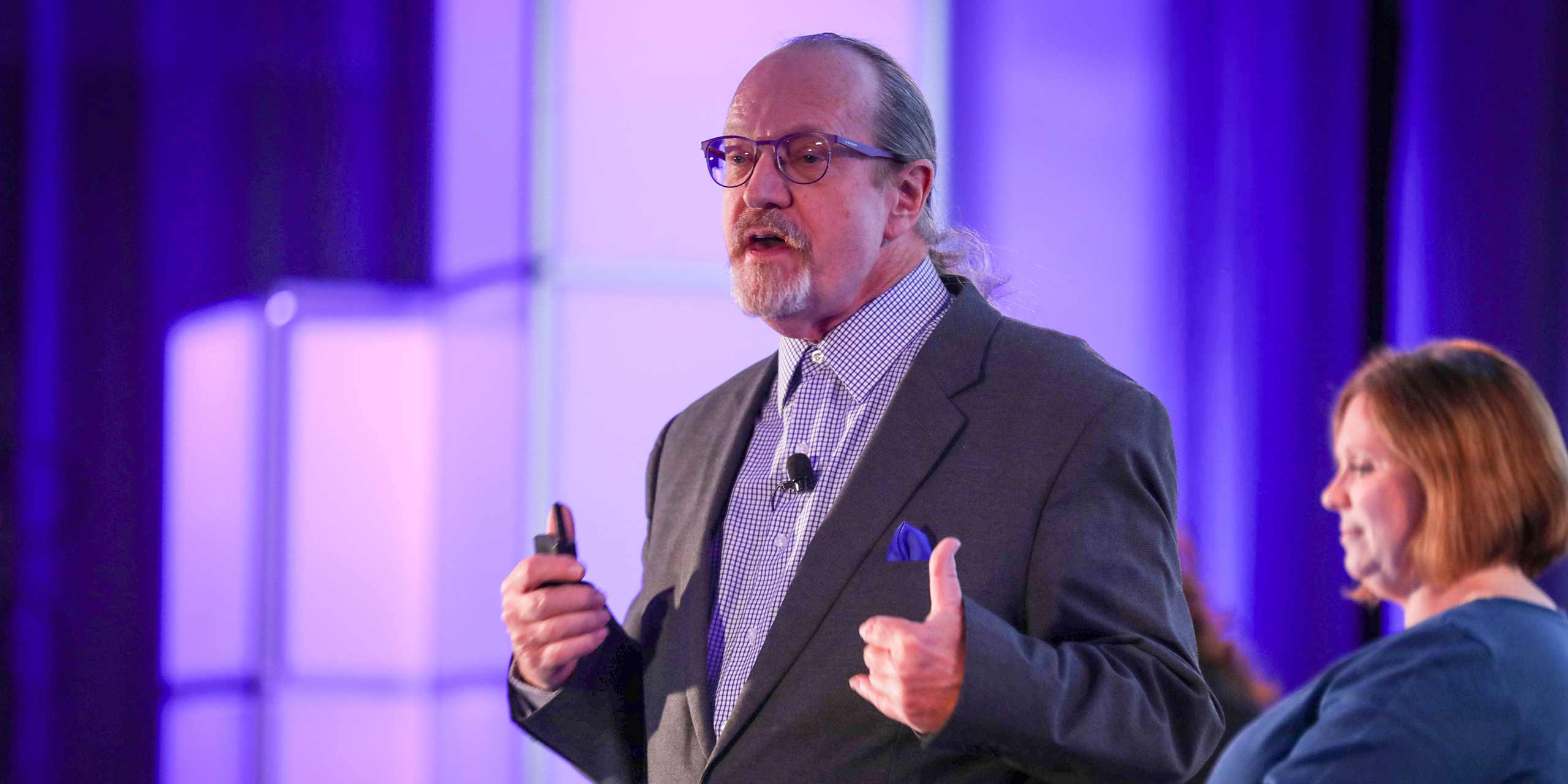
“We all want something different, but we also want something similar.” Grek Kitzmiller, Marketing, Indiana University. Photograph: Carla Antonio/Top Hat
In one of the panel discussion’s many compelling moments, Kitzmiller addressed the use of classroom response systems by asking the hundreds of faculty members in attendance to complete the following sentence: “My main goal for using a response system like Top Hat is…” (He also humorously modeled his behaviour with students in these classroom-response situations, giving the audience an ominous countdown as time ticked away on the question. Kitzmiller does this to prod students who wait until the last second before inputting their answer, a game he calls “clicker chicken.”)
The answers included terms such as engagement, participation, learning and retention—all of which Kitzmiller used to reinforce what he considers a key lesson. “What you see here is that we all want something different, but we also want something similar,” he said. “And that’s a very powerful realization.”
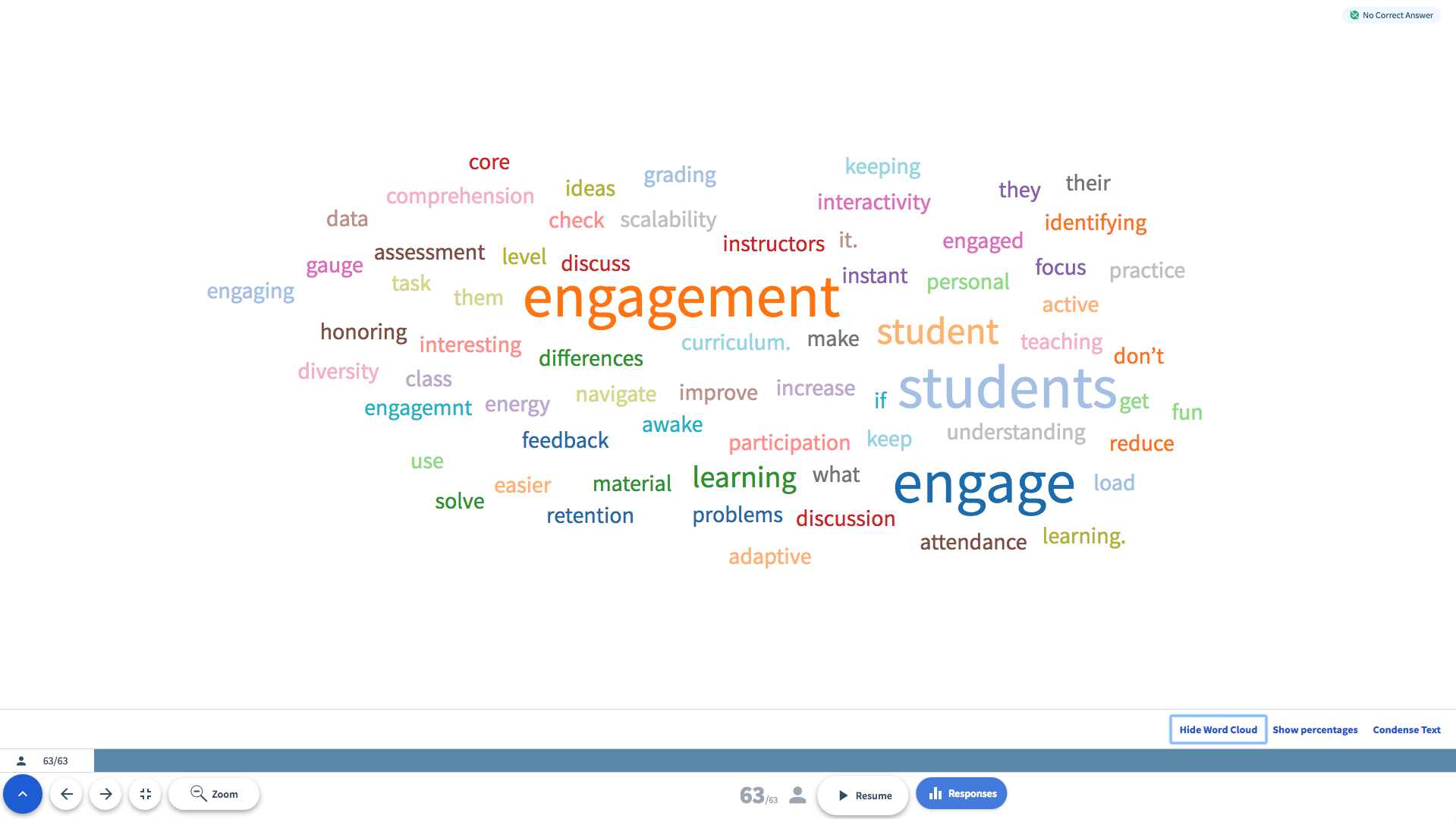
Kitzmiller’s lesson also helps to establish some parameters for the concept of personalized instruction. The first is that a classroom continues to work towards a common goal. The second is that students themselves must be active participants in personalizing their own learning.
Personalized learning, whether tailored by algorithms or by professors and their TAs, is driven first and foremost by the individual’s input. The most basic form of personalization is for students to ask questions about the course material, which allows faculty to respond to their specific misunderstandings. For her introductory psychology courses, Cavazos maintains an open online discussion board for the duration of every class through Top Hat, where students can post questions anonymously or—in keeping with Kitzmiller’s idea that people all want something different yet similar—express support for other students’ questions, which “votes” them higher up the queue.
“We all know that, in large classrooms, some students are reluctant to raise their hands and ask questions,” Cavazos says. “So this is a simple way to get around that. The discussion board is anonymous so it mitigates those fears.” She has teaching assistants who monitor the board, including which students are posting to it, to make sure student posts remain positive and constructive. “I tell my students, ‘your questions and comments are anonymous to the group, but they are not anonymous to me, and I will find you if your comments are out of bounds.’” Cavazos also structures group work, putting students in groups of six to work with herself and her TAs.
Personalizing for different levels of understanding
Some institutions and departments are attempting more structured and formal approaches to personalized education. At the University of Pittsburgh, professor Candice Damiani, who also presented at the conference, is taking part in her institution’s efforts to structure personalized education for students in the school’s two Foundations of Biology courses.
“In my Foundations of Biology 2 course, about one third of my students are repeating the course, one third are straight out of high school, and one third are what I’d call on schedule,” Damiani explains. “They arrive with very different levels of understanding about the curriculum we cover, and a variety of life circumstances that impact their ability to learn. What we’re trying to do is devise a way to assess those individual needs and give them a better chance to succeed.”
Damiani’s department has developed an in-house pre-assessment: a set of fifteen questions that give the school a sense of where students are at as they enter Foundations 1. The assessment is administered again at the end of the course, and again before the start of Foundations 2. “What we’ve learned is that their average scores have dropped over the summer, between the time when they finished Foundations 1 and the first class for Foundations 2,” she explains. “So they are forgetting some of the things they’ve learned.”
Damiani explains that she is not allowed to see individual data, to protect students against any bias that might emerge as a result. But the data can help her learn where student retention and understanding have slipped so that she can review those topics in greater depth.
The plan, says Damiani, is to eventually develop mini-modules on each of the topics covered in the pre-assessment. “The idea is that, if the pre-assessment shows they lack understanding of the biology of water, for example, then they will automatically be assigned a homework module on that topic which they must complete before they start my Foundations 2 class,” she says. “That’s the kind of personalization we think can really benefit students.”
Cavazos points out that current educational technology has the ability to provide a similar form of short-term personalization by linking questions together in a chain. “We can ask a question through a technology platform and then have subsequent questions linked to their prior answers,” she says. It’s similar to the process Damiani is helping to establish, but on a smaller scale: a single question, or small group of questions, serves as a pre-assessment that automatically triggers additional exercises as needed, based upon the answers.
I don’t come to class with a lecture script or a lesson plan. I come with a playbook.
In contrast to such structured programs, other faculty members approach personalization in a more free-flowing manner. Alva Couch, a professor of computer science at Tufts University near Boston, says he takes a more open-ended approach to personalization. “I don’t come to class with a lecture script or a lesson plan,” he says. “I come with a playbook.”
The way Couch describes it, instead of preparing a list of material to get through, he’ll arrive in class with a few learning objectives to accomplish. He then begins each class by asking his students questions based upon what he wants to achieve that day. “I try to figure out what knowledge they already have, what they need, and what obstacles are likely to be in our way,” he says. “Then I try to map a path that will get us to where we need to be.”
Couch’s approach may not personalize the learning experience by tailoring it down to every individual student’s needs—but he is encouraging the group to express its needs, and letting those needs guide his teaching. It’s something Kitzmiller tries to do as well. “I can make them feel like individuals if I show concern for them as individuals. I am reaching out to them as individuals, and that’s what makes the difference.”
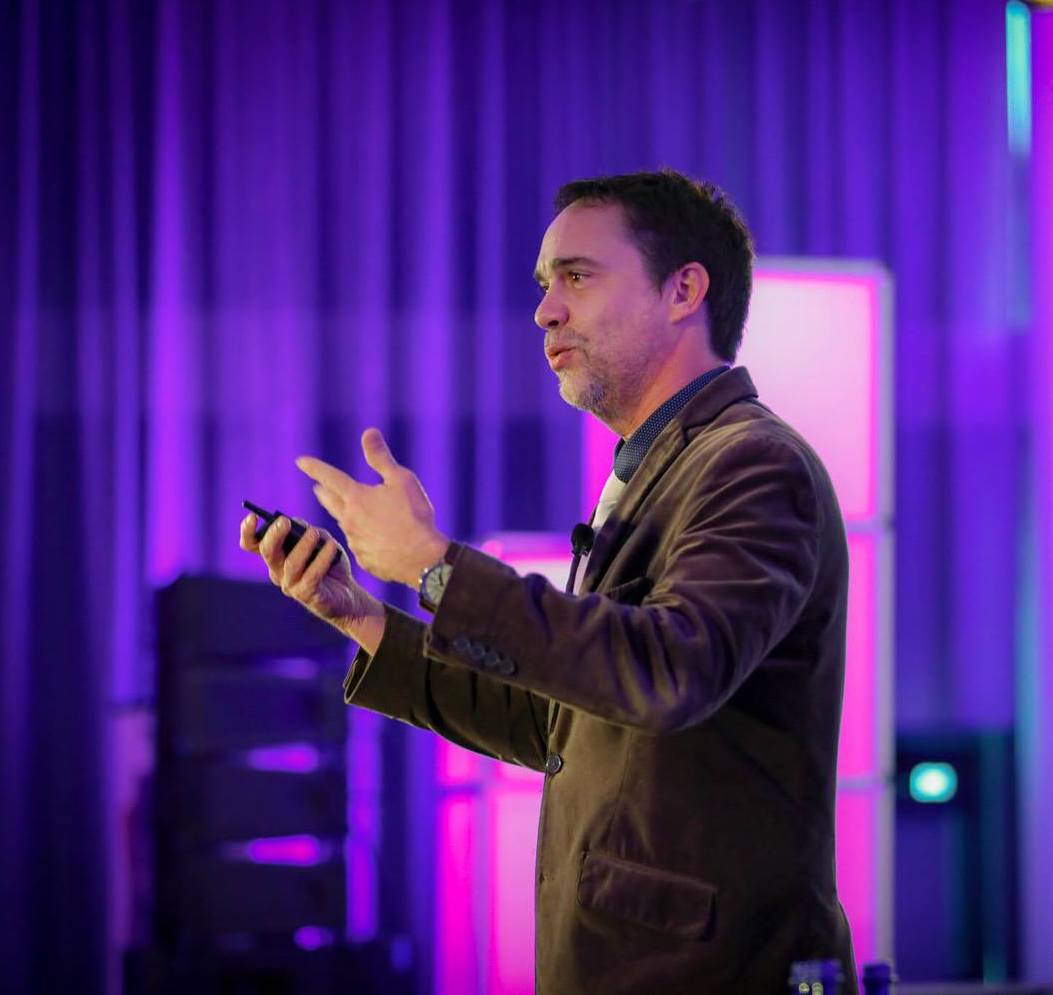
Watch on demand
The Evolution of Instruction: A New Paradigm for Teaching
José Vazquez, professor of economics at the University of Illinois, discusses what he envisions as the future of teaching in higher ed, and the various ways students stand to benefit from self-paced learning and a re-imagination of the role of the college instructor.
Sign-up below to watch the recording for free.
Related pages
Learn how to increase student success in the online classroom using Top Hat
